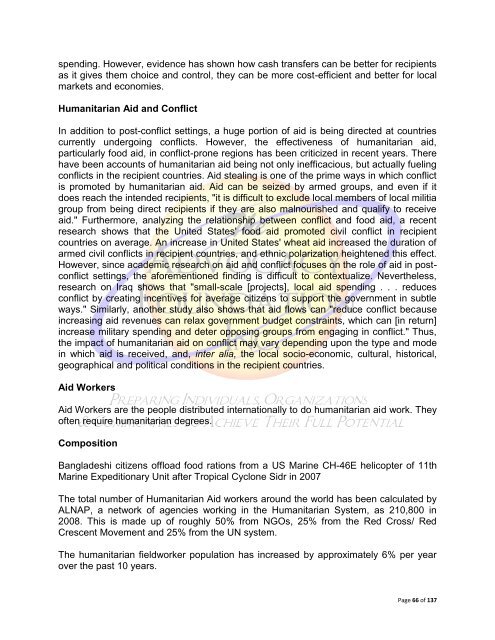The Theology of Missions
The Theology of Missions
The Theology of Missions
Create successful ePaper yourself
Turn your PDF publications into a flip-book with our unique Google optimized e-Paper software.
spending. However, evidence has shown how cash transfers can be better for recipients<br />
as it gives them choice and control, they can be more cost-efficient and better for local<br />
markets and economies.<br />
Humanitarian Aid and Conflict<br />
In addition to post-conflict settings, a huge portion <strong>of</strong> aid is being directed at countries<br />
currently undergoing conflicts. However, the effectiveness <strong>of</strong> humanitarian aid,<br />
particularly food aid, in conflict-prone regions has been criticized in recent years. <strong>The</strong>re<br />
have been accounts <strong>of</strong> humanitarian aid being not only inefficacious, but actually fueling<br />
conflicts in the recipient countries. Aid stealing is one <strong>of</strong> the prime ways in which conflict<br />
is promoted by humanitarian aid. Aid can be seized by armed groups, and even if it<br />
does reach the intended recipients, "it is difficult to exclude local members <strong>of</strong> local militia<br />
group from being direct recipients if they are also malnourished and qualify to receive<br />
aid." Furthermore, analyzing the relationship between conflict and food aid, a recent<br />
research shows that the United States' food aid promoted civil conflict in recipient<br />
countries on average. An increase in United States' wheat aid increased the duration <strong>of</strong><br />
armed civil conflicts in recipient countries, and ethnic polarization heightened this effect.<br />
However, since academic research on aid and conflict focuses on the role <strong>of</strong> aid in postconflict<br />
settings, the aforementioned finding is difficult to contextualize. Nevertheless,<br />
research on Iraq shows that "small-scale [projects], local aid spending . . . reduces<br />
conflict by creating incentives for average citizens to support the government in subtle<br />
ways." Similarly, another study also shows that aid flows can "reduce conflict because<br />
increasing aid revenues can relax government budget constraints, which can [in return]<br />
increase military spending and deter opposing groups from engaging in conflict." Thus,<br />
the impact <strong>of</strong> humanitarian aid on conflict may vary depending upon the type and mode<br />
in which aid is received, and, inter alia, the local socio-economic, cultural, historical,<br />
geographical and political conditions in the recipient countries.<br />
Aid Workers<br />
Aid Workers are the people distributed internationally to do humanitarian aid work. <strong>The</strong>y<br />
<strong>of</strong>ten require humanitarian degrees.<br />
Composition<br />
Bangladeshi citizens <strong>of</strong>fload food rations from a US Marine CH-46E helicopter <strong>of</strong> 11th<br />
Marine Expeditionary Unit after Tropical Cyclone Sidr in 2007<br />
<strong>The</strong> total number <strong>of</strong> Humanitarian Aid workers around the world has been calculated by<br />
ALNAP, a network <strong>of</strong> agencies working in the Humanitarian System, as 210,800 in<br />
2008. This is made up <strong>of</strong> roughly 50% from NGOs, 25% from the Red Cross/ Red<br />
Crescent Movement and 25% from the UN system.<br />
<strong>The</strong> humanitarian fieldworker population has increased by approximately 6% per year<br />
over the past 10 years.<br />
Page 66 <strong>of</strong> 137

















